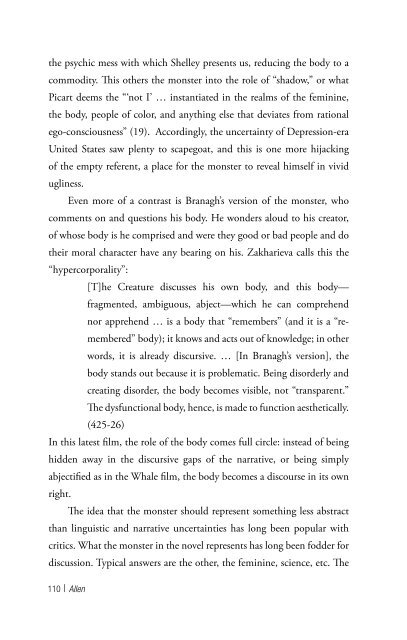Untitled - California State University, Long Beach
Untitled - California State University, Long Beach
Untitled - California State University, Long Beach
Create successful ePaper yourself
Turn your PDF publications into a flip-book with our unique Google optimized e-Paper software.
the psychic mess with which Shelley presents us, reducing the body to a<br />
commodity. This others the monster into the role of “shadow,” or what<br />
Picart deems the “‘not I’ … instantiated in the realms of the feminine,<br />
the body, people of color, and anything else that deviates from rational<br />
ego-consciousness” (19). Accordingly, the uncertainty of Depression-era<br />
United <strong>State</strong>s saw plenty to scapegoat, and this is one more hijacking<br />
of the empty referent, a place for the monster to reveal himself in vivid<br />
ugliness.<br />
Even more of a contrast is Branagh’s version of the monster, who<br />
comments on and questions his body. He wonders aloud to his creator,<br />
of whose body is he comprised and were they good or bad people and do<br />
their moral character have any bearing on his. Zakharieva calls this the<br />
“hypercorporality”:<br />
[T]he Creature discusses his own body, and this body—<br />
fragmented, ambiguous, abject—which he can comprehend<br />
nor apprehend … is a body that “remembers” (and it is a “remembered”<br />
body); it knows and acts out of knowledge; in other<br />
words, it is already discursive. … [In Branagh’s version], the<br />
body stands out because it is problematic. Being disorderly and<br />
creating disorder, the body becomes visible, not “transparent.”<br />
The dysfunctional body, hence, is made to function aesthetically.<br />
(425-26)<br />
In this latest film, the role of the body comes full circle: instead of being<br />
hidden away in the discursive gaps of the narrative, or being simply<br />
abjectified as in the Whale film, the body becomes a discourse in its own<br />
right.<br />
The idea that the monster should represent something less abstract<br />
than linguistic and narrative uncertainties has long been popular with<br />
critics. What the monster in the novel represents has long been fodder for<br />
discussion. Typical answers are the other, the feminine, science, etc. The<br />
110 | Allen<br />
movies sometimes buy into these intellectualizations, but since the movie<br />
versions heavily fetishize the physicality of the monster, it is possible<br />
that they more basically work to relieve the terror of the unknown that<br />
Derrida posits. One could argue that the fear of the unknown is what<br />
underlies these physical—often increasingly violent—portrayals, and<br />
that they fail to assuage our deep-seated fears. However, one fascinating<br />
aspect of horror films as a genre is that what shocked audiences in past<br />
generations no longer produces the same effect with later audiences.<br />
What these films are more likely doing is trying to depict rather<br />
than relieve these fears, but the visual language they use becomes trite<br />
simply because the ever-progressing technical aspect of filmmaking<br />
keeps pushing audiences’ expectations of how violence is portrayed. It<br />
is the same with the other great taboo that we fetishize on the screen:<br />
the sex act. I do not need to innumerate how portrayals of physical sex<br />
have become more explicit and increasingly less suggestive throughout<br />
the history of cinema, especially over the last forty years. Picart notes<br />
that Branagh’s film portrays an “unabashed display of sexuality, and<br />
startling[ly] showcase[s] … dismembered body parts, yet does so with a<br />
certain deftness that prevents these technical resonances from being mere<br />
clichés” (26). “Frankenstein” merely evolves with the times. If he rears his<br />
ugly head, it is not because we seek to de-repress, but because he demands<br />
to be seen, to crawl up from the depth of the psyche—but he must do so<br />
on each generation’s terms.<br />
When we title a movie as “Frankenstein,” we have to contend with<br />
the baggage of not only what Mary Shelley wrote, but also what she<br />
refused to write. Instead of the failing of science, or of a single man, or<br />
of the family as the center of the narrative, we have a body to represent<br />
whatever it is politically and culturally convenient to impose upon it.<br />
That monster, particularly the fact that his body is an empty referent,<br />
plays on repressed fears, and we cannot transcend or assuage those fears,<br />
Allen | 111
















